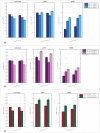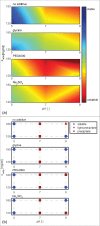Characterization of highly concentrated antibody solution - A toolbox for the description of protein long-term solution stability
- PMID: 28617076
- PMCID: PMC5627599
- DOI: 10.1080/19420862.2017.1338222
Characterization of highly concentrated antibody solution - A toolbox for the description of protein long-term solution stability
Abstract
High protein titers are gaining importance in biopharmaceutical industry. A major challenge in the development of highly concentrated mAb solutions is their long-term stability and often incalculable viscosity. The complexity of the molecule itself, as well as the various molecular interactions, make it difficult to describe their solution behavior. To study the formulation stability, long- and short-range interactions and the formation of complex network structures have to be taken into account. For a better understanding of highly concentrated solutions, we combined established and novel analytical tools to characterize the effect of solution properties on the stability of highly concentrated mAb formulations. In this study, monoclonal antibody solutions in a concentration range of 50-200 mg/ml at pH 5-9 with and without glycine, PEG4000, and Na2SO4 were analyzed. To determine the monomer content, analytical size-exclusion chromatography runs were performed. ζ-potential measurements were conducted to analyze the electrophoretic properties in different solutions. The melting and aggregation temperatures were determined with the help of fluorescence and static light scattering measurements. Additionally, rheological measurements were conducted to study the solution viscosity and viscoelastic behavior of the mAb solutions. The so-determined analytical parameters were scored and merged in an analytical toolbox. The resulting scoring was then successfully correlated with long-term storage (40 d of incubation) experiments. Our results indicate that the sensitivity of complex rheological measurements, in combination with the applied techniques, allows reliable statements to be made with respect to the effect of solution properties, such as protein concentration, ionic strength, and pH shift, on the strength of protein-protein interaction and solution colloidal stability.
Keywords: Conformational and colloidal stability; monoclonal antibodies; phase diagram; thermal stability; viscoelasticity; viscosity; zeta-potential.
Figures








Similar articles
-
Studying Excipient Modulated Physical Stability and Viscosity of Monoclonal Antibody Formulations Using Small-Angle Scattering.Mol Pharm. 2019 Oct 7;16(10):4319-4338. doi: 10.1021/acs.molpharmaceut.9b00687. Epub 2019 Sep 24. Mol Pharm. 2019. PMID: 31487466
-
Improving Viscosity and Stability of a Highly Concentrated Monoclonal Antibody Solution with Concentrated Proline.Pharm Res. 2018 Apr 30;35(7):133. doi: 10.1007/s11095-018-2398-1. Pharm Res. 2018. PMID: 29713822
-
Application of high-frequency rheology measurements for analyzing protein-protein interactions in high protein concentration solutions using a model monoclonal antibody (IgG2).J Pharm Sci. 2006 Sep;95(9):1967-83. doi: 10.1002/jps.20663. J Pharm Sci. 2006. PMID: 16847932
-
Spectroscopic methods for assessing the molecular origins of macroscopic solution properties of highly concentrated liquid protein solutions.Anal Biochem. 2018 Nov 15;561-562:70-88. doi: 10.1016/j.ab.2018.09.013. Epub 2018 Sep 20. Anal Biochem. 2018. PMID: 30243977 Review.
-
NMR spectroscopy as a characterization tool enabling biologics formulation development.J Pharm Biomed Anal. 2023 Jan 20;223:115110. doi: 10.1016/j.jpba.2022.115110. Epub 2022 Oct 14. J Pharm Biomed Anal. 2023. PMID: 36308923 Review.
Cited by
-
Computational prediction of protein aggregation: Advances in proteomics, conformation-specific algorithms and biotechnological applications.Comput Struct Biotechnol J. 2020 Jun 10;18:1403-1413. doi: 10.1016/j.csbj.2020.05.026. eCollection 2020. Comput Struct Biotechnol J. 2020. PMID: 32637039 Free PMC article. Review.
-
Web-based display of protein surface and pH-dependent properties for assessing the developability of biotherapeutics.Sci Rep. 2019 Feb 13;9(1):1969. doi: 10.1038/s41598-018-36950-8. Sci Rep. 2019. PMID: 30760735 Free PMC article.
-
Antibody Structure and Function: The Basis for Engineering Therapeutics.Antibodies (Basel). 2019 Dec 3;8(4):55. doi: 10.3390/antib8040055. Antibodies (Basel). 2019. PMID: 31816964 Free PMC article. Review.
-
Protein aggregation and immunogenicity of biotherapeutics.Int J Pharm. 2020 Jul 30;585:119523. doi: 10.1016/j.ijpharm.2020.119523. Epub 2020 Jun 9. Int J Pharm. 2020. PMID: 32531452 Free PMC article. Review.
-
Assessment of Therapeutic Antibody Developability by Combinations of In Vitro and In Silico Methods.Methods Mol Biol. 2022;2313:57-113. doi: 10.1007/978-1-0716-1450-1_4. Methods Mol Biol. 2022. PMID: 34478132
References
-
- Rosman Z, Shoenfeld Y, Zandmann-Goddard G. Biologic therapy for autoimmune diseases: An update. BMC Med 2013; 11:88; PMID:23557513; https://doi.org/10.1186/1741-7015-11-88 - DOI - PMC - PubMed
-
- Scott A, Wolchok J, Old L. Antibody therapy of cancer. Nat Rev Cancer 2012; 12:14; PMID:22437872; https://doi.org/10.1038/nrc3236 - DOI - PubMed
-
- Shire SJ, Shahrokh Z, Liu JUN. Challenges in the development of high protein concentration formulations. J Pharm Sci 2004; 93:1390-402; PMID:15124199; https://doi.org/10.1002/jps.20079 - DOI - PubMed
-
- Pindrus M, Shire S, Kelley R, Demeule B, Wong R. Solubility challenges in high concentration monoclonal antibody formulations: Relationship with amino acid sequence and intermolecular interactions. Mol Pharm 2015; 12:3896-907; PMID:26407030; https://doi.org/10.1021/acs.molpharmaceut.5b00336 - DOI - PubMed
-
- Leckband D, Sivasankar S. Forces controlling protein interactions: Theory and experiment. Cool Surfaces B Biointerfaces 1999; 14:83-97; https://doi.org/10.1016/S0927-7765(99)00027-2 - DOI
Publication types
MeSH terms
Substances
LinkOut - more resources
Full Text Sources
Other Literature Sources
